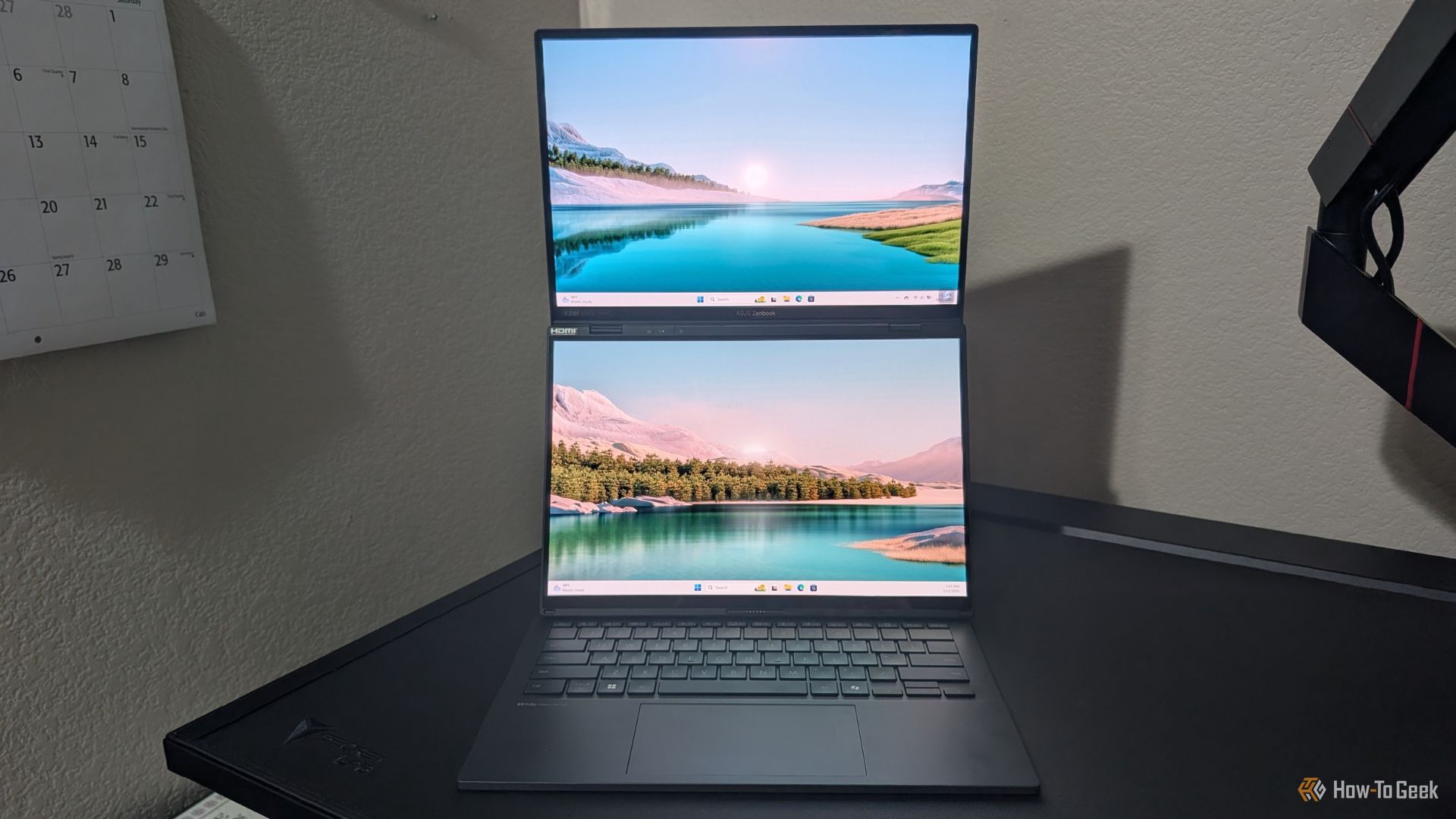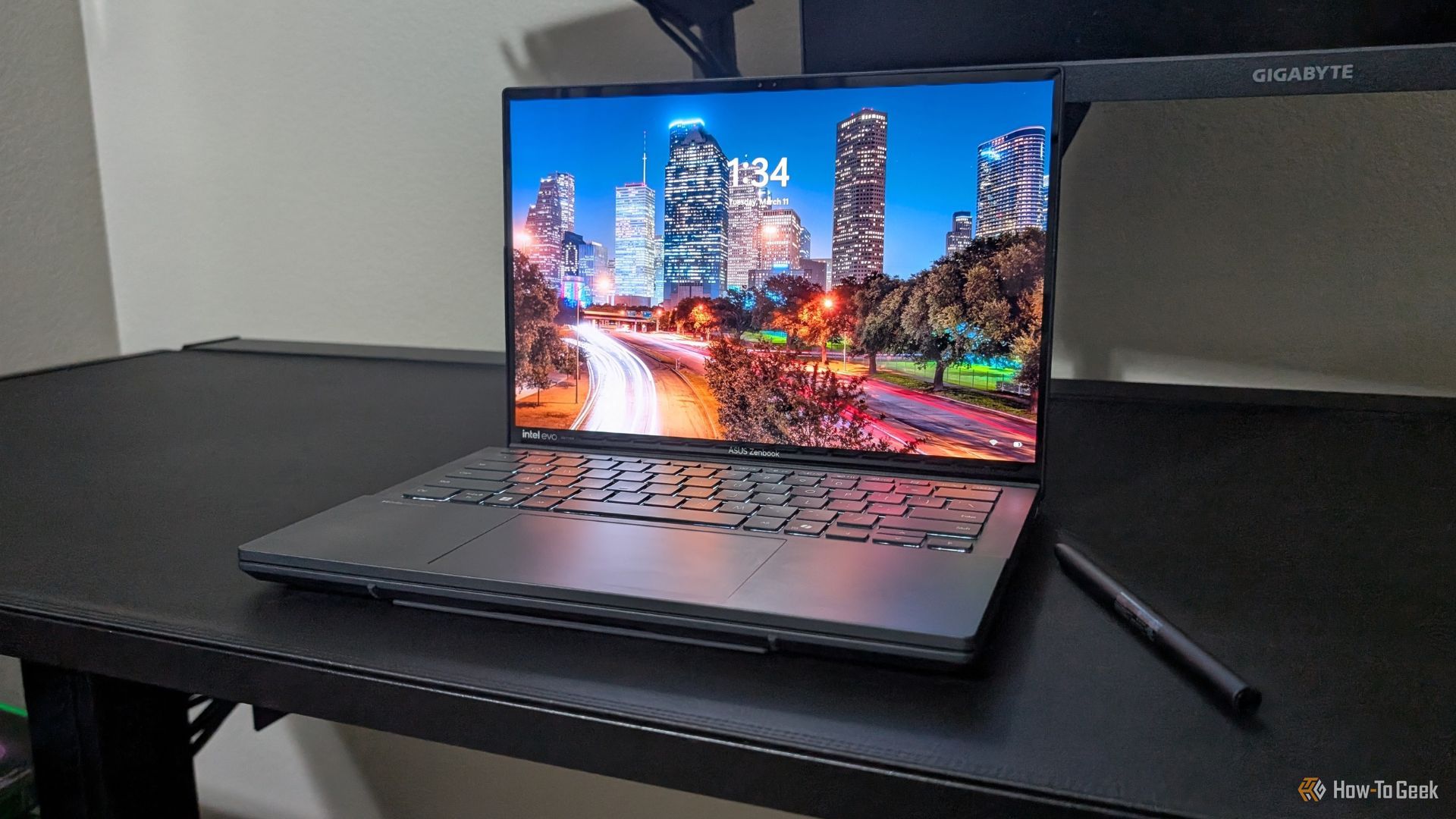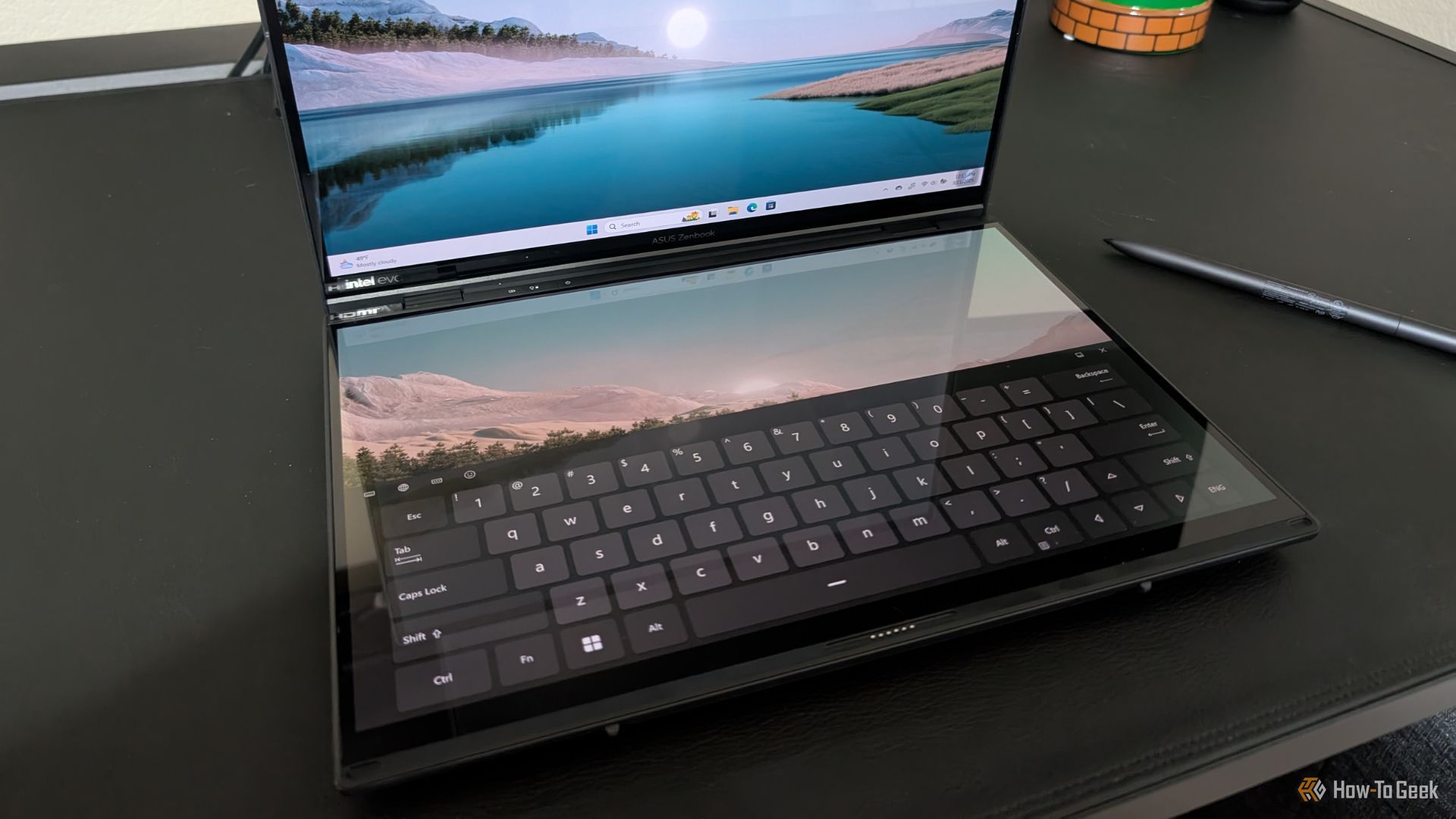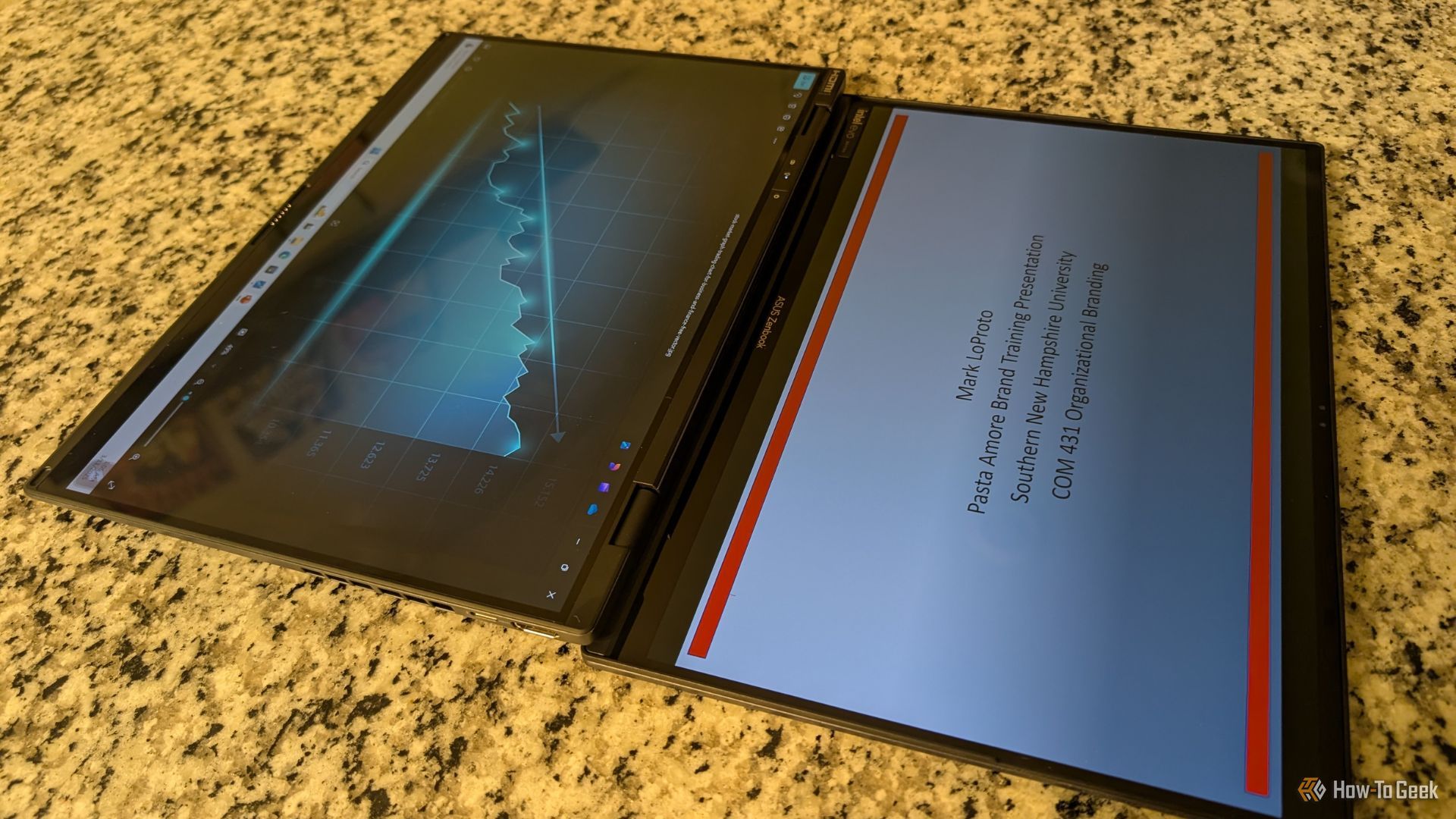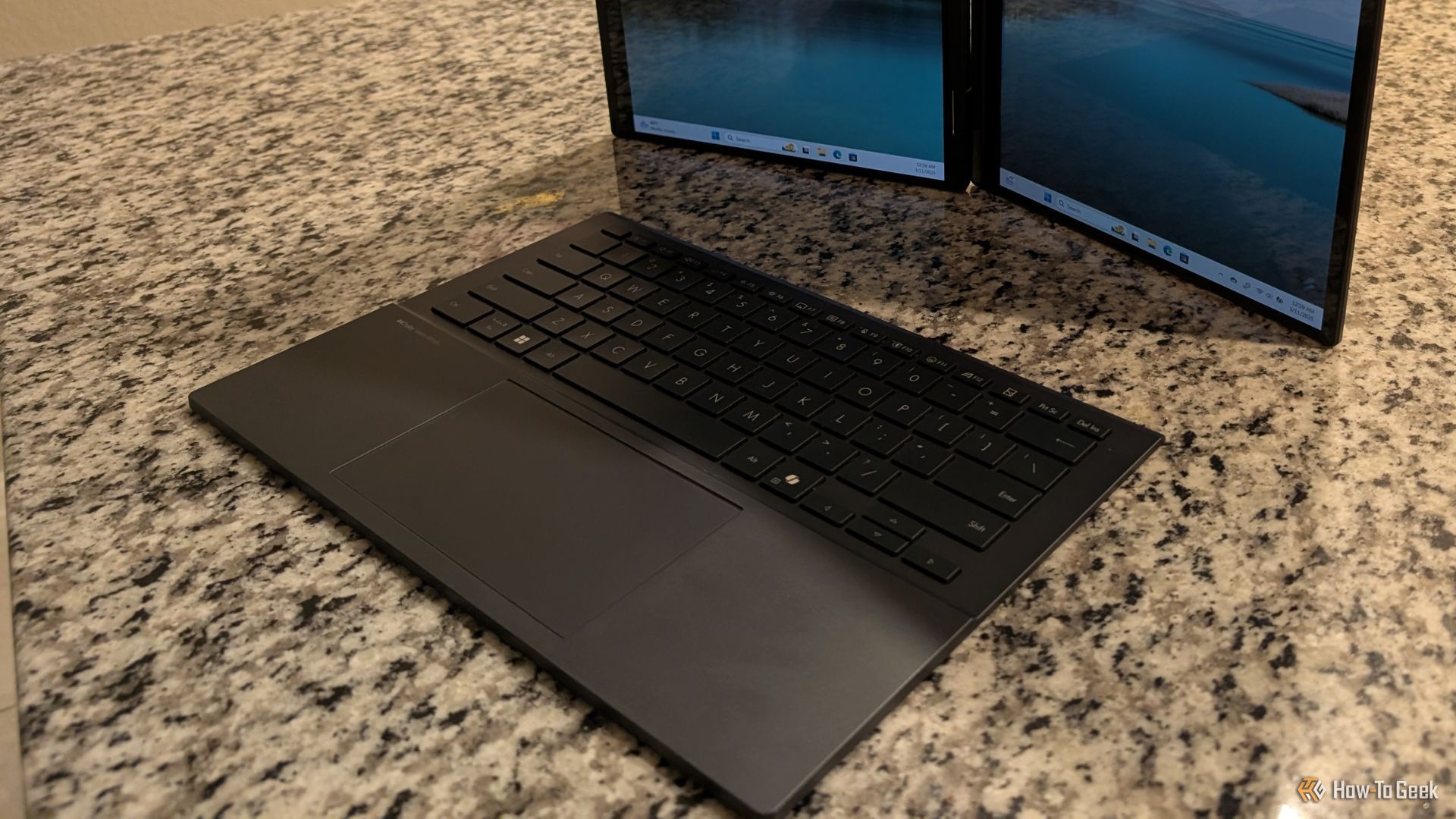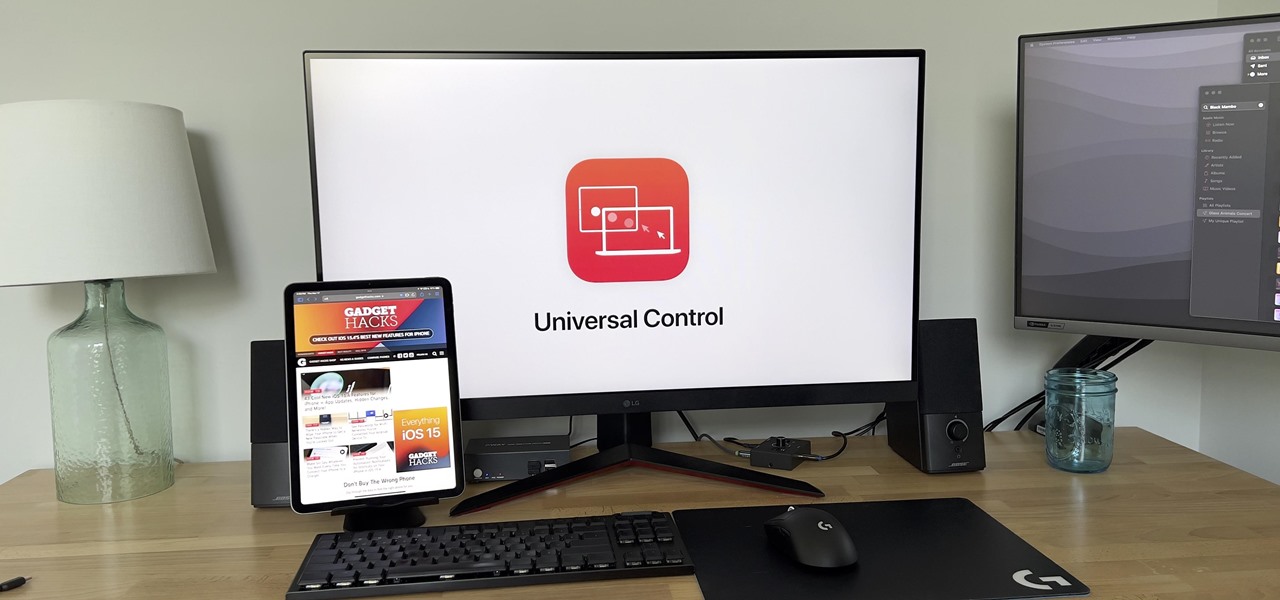ASUS’ Dual-Monitor Laptop Has Me Rethinking My Bulky Workstation
Summary
- ASUS Zenbook Duo offers a powerful Intel Core 9 200-series processor that can tackle resource-hungry tasks.
- The seamless transition between five user modes adds versatility without complicating usability.
- Battery life is a concern, but the Zenbook Duo’s features can still make it worthwhile for multitasking.
Dual-monitor laptops risk being bulky and inefficient. ASUS’ Zenbook Duo may be heavy, but it’s more than just a laptop. It’s a reliable, multi-use, portable workstation with a few manageable quirks and curious design choices.

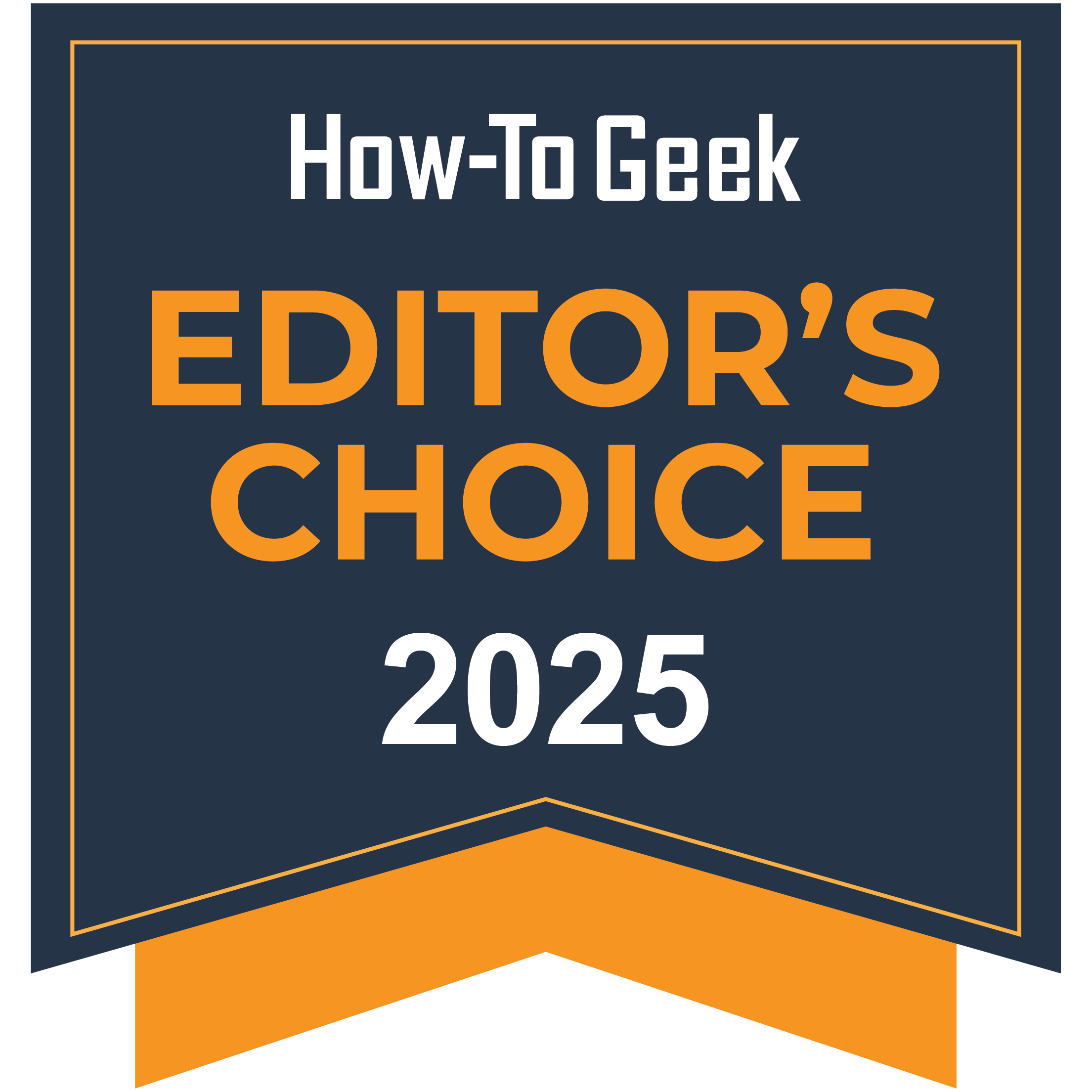
ASUS Zenbook DUO (2025)
ASUS delivers a powerful, reliable, dual-monitor workstation that’s perfect for presentations, daily office work, and so much more thanks to its Intel Core Ultra 9 processor, 32GB memory, and fast-charging battery. The Zenbook Duo is designed to cater to a host of users, and ASUS does exactly that with very few glaring limitations or issues.
- Seamlessly switch between five user modes
- Intel’s Ultra 9 200 series is a reliable, powerful processor
- Vibrant, durable Gorilla Glass screens offer pristine clarity
- Bluetooth keyboard offers comfortable, responsive typing
- Battery life could be better
- On the bulkier and heavier side
- No vertical stand for desktop mode
- Very light on the available ports
$1799.99 at ASUS
$1699.99 at Amazon
Price and Availability
ASUS’ Zenbook Duo is available via the official ASUS store in two configurations. The cheapest, at $1,699, comes with an Intel Core Ultra 7 255H processor, 32GB RAM, and a 1TB SSD. For $1,799.99, the Zenbook Duo is equipped with an Intel Core Ultra 9 285H processor and the same RAM and storage as the cheaper model. The same configurations are also available on Amazon for $1,699.99.
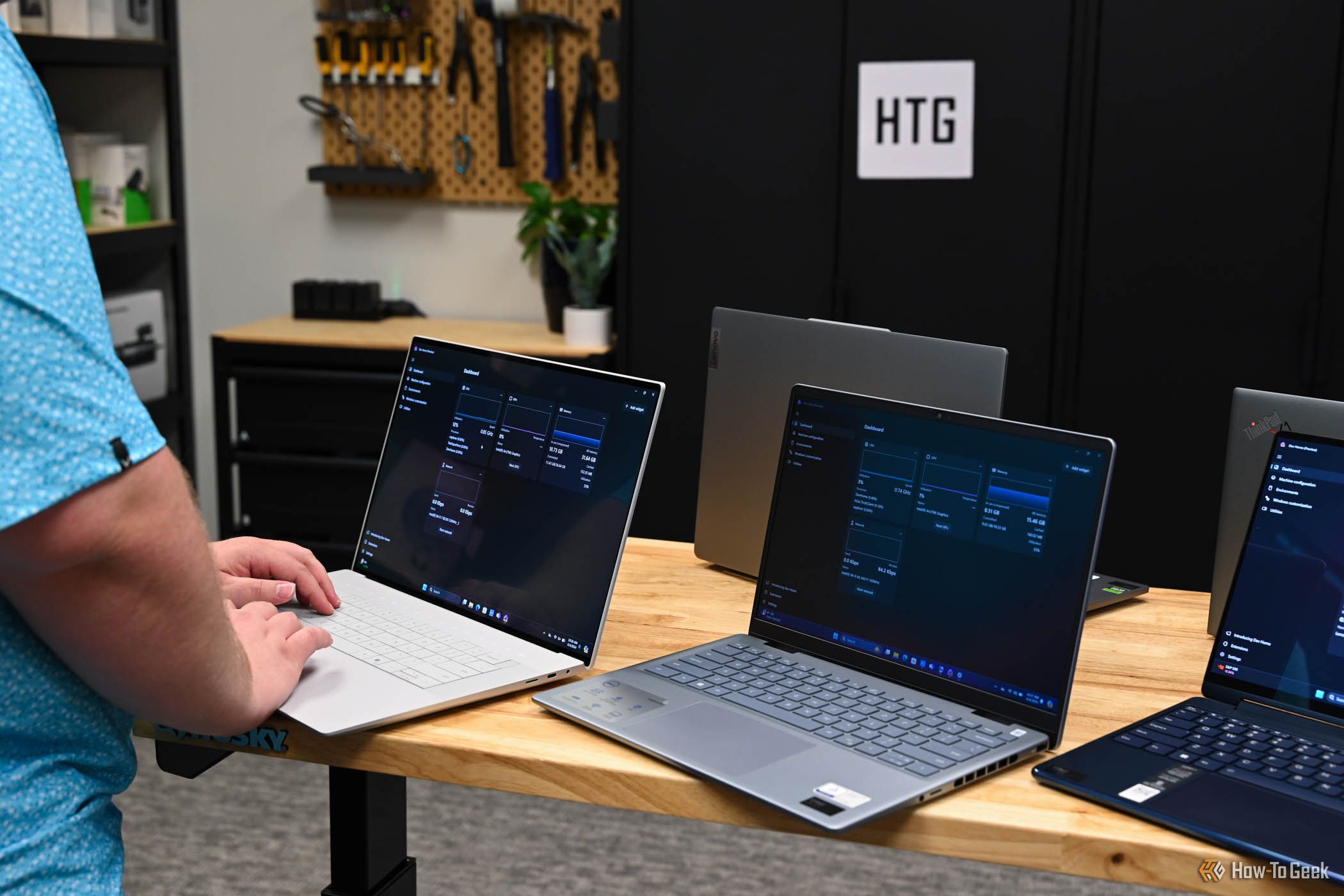
See Our Process
How We Test and Review Products at How-To Geek
We go hands-on with every product to ensure it’s worth your time and money.
Bulky but Still Portable Enough
Coming off using the HP Spectre X360, which earned a best laptop nod for 2024, the ASUS Zenbook Duo was marginally heavier and thicker. Despite the extra 14-inch screen, the laptop only weighs an additional .45 pounds and is less than a quarter of an inch higher when closed. It’s a bulk you can get used to and not something that will bog down your laptop bag or luggage. It was the easiest part of the transition from HP’s sleek Spectre, as the Zenbook Duo lands itself in an entirely different category from your typical laptop.
The Zenbook’s portability is arguably more impressive than any standard laptop. Even those that fold over into a convenient tablet mode, like the Spectre. Considering what the Zenbook is capable of, and how well it pulls most of it off, I was surprised that there wasn’t more of a disparity in size. After all, you’d expect something that could replace an entire two-monitor workstation to be fairly sizable.
That’s not the case at all, and it speaks to the overall experience with the Zenbook Duo. At every turn, I expected something to disappoint or be unimpressive. Save for a few minor quirks that can be overlooked, I was very rarely frustrated during my time working on ASUS’ portable workstation.
Vibrant Dual Displays
The stars of this efficient package are the dual 14-inch displays. Though there’s no guarantee you’ll use both screens equally, ASUS didn’t skimp on either. Top and bottom, the laptop is equipped with ASUS Lumina OLED displays, rated at 2880 x 1800 resolution and capable of a 120Hz refresh rate. Since this is more a workstation and portable office computer, there’s really no need for a higher refresh rate, and it’s evident that ASUS pooled its resources into the visuals of a high-quality OLED.
The result is a pair of equally vibrant screens that are very easy to work on, whether you’re piecing together a color-reliant presentation or writing a wordy review about how much a dual-monitor laptop surprised you. Being touchscreens, ASUS opted for scratch-resistant Corning Gorilla Glass, which lends to durability and a much smoother image.
Unfortunately, I feel the screens are where the laptop’s biggest pitfall stems from. I’ll talk more about the battery shortly, but keeping both displays running is a significant power drain.
Impressive Performance Across All Five Modes
ASUS wasn’t willing to cater to just one or two user groups with the Zenbook Duo. Rather, it offers five distinct modes. Along with a standard laptop mode, where the Bluetooth keyboard rests on the secondary screen at a height that takes some adjusting, there’s also the dual-screen option with a virtual keyboard.
The laptop is stabilized horizontally with a sturdy stand to emulate a two-monitor desktop. A little less efficient is the vertical desktop mode. There’s no vertical stand, so you’ll either need to keep the laptop partially closed or rely on the horizontal stand, which supports only one screen at an awkward angle.
Finally, there’s a sharing mode, which highlights the Zenbook’s usefulness as a portable workstation. It’s a smooth transition from completing a report to presenting to a table of people without HDMI cables, secondary monitors, or virtual casting. While each mode has its merits, I mostly used both displays to research and write. I didn’t have a practical purpose for sharing mode, but I can see its usefulness for, say, a real estate agent showing off a virtual walkthrough or an interior designer going over a blueprint with a client.
The Zenbook is a versatile laptop, though a more flexible hinge would have been nice. In sharing mode, there’s no “tent” option, so parties can have a head-on view instead of hovering over the flat displays. Speakers could also have notes open while showing off graphs, charts, and all else.
Intel’s Ultra 200 Series is Up for Virtually All Tasks
The model I reviewed came with an Ultra 9, but there is a model with an Ultra 7 200-series, as well. It really didn’t matter how I used the Zenbook Duo. Intel’s Ultra 200-series processor optimized resources for quiet, mostly flawless operation. I used the Zenbook as I do any other laptop, and I’m confident that it was one of the best at managing my workload. The fan very rarely ran high, and the laptop never really got hot, even when using both screens and running heavier tasks.
I was sure there’d be issues with temperature, but ASUS’ IceCool technology manages heat distribution well by separating the CPU and motherboard, creating air gaps, and using a pair of heat pipes and fans. In fact, ASUS sacrificed additional ports for more ventilation on either side of the laptop’s lower screen.
Things like video editing (using the somewhat resource-hungry Movavi editor) and photo editing with Photoshop pushed other laptops I’ve used. Even the HP Spectre X360 stuttered with some of Photoshop’s tools, like adding lighting or 3D effects. The Zenbook handled it all gracefully, which is critical for a device that’s essentially emulating a dual-monitor desktop.
Despite not being a gaming PC, curiosity got the best of me, so I still ran a benchmark test. Through 3DMark, the Zenbook Duo scored a 3,507 in the Steel Nomad Light test. This was above the 3,078 average, and about 300 points below the best score. Intel’s pairing of the Arc 140T GPU and Ultra 9 285H makes for a laptop that doesn’t shy away from the task at hand.
ASUS Encourages Interactivity and Sharing
With both screens being touch responsive, a series of gestures provides control over specific quick commands, like launching the virtual keyboard with three fingers or swiping outward with five fingers to fill the screen. I’ve always been a bit skeptical about whether these motions are ever used. Now, I can see the vision a little better, especially with share mode.
Other features that I really enjoyed tinkering with included Task Groups, which allow users to arrange specific apps into designated windows and open them in that arrangement with the click of a button. This and Window Flick, which sends an app to the opposite screen with a quick flick of a finger, drove home that the two screens aren’t just for one person. They’re to simplify presentations in a number of helpful ways.
Adding to the convenience is the ASUS Pen 2.0. It’s a fine companion device for graphic artists and anyone taking quick notes. However, I was immediately put off by the lack of a magnet or anything to keep it tethered to the laptop. The pen is on the larger side, so it should be harder to lose, but it would still be nice to have that added security.
A Sturdy, Comfortable Typing Experience
I spent a few minutes typing on the virtual keyboard and am not entirely sure when it’s necessary, save for if the Bluetooth keyboard is dead. It’s an awkward and slightly uncomfortable alternative, and only really solves one problem (a dead keyboard). So, you’re definitely going to want to keep the Bluetooth keyboard charged, which you can do via its own USB-C port or by keeping it in place while the laptop is plugged in. Considering it lasts much longer than the laptop battery, chances are it will always have a decent charge.
The board itself is comfortable to type on, offering a quiet click and responsive flat keys. My only real gripe is that my palm occasionally connected with the large touchpad. Shrunken down a little more, I think it would still be a great size for the keyboard while accommodating larger hands.
Not Too Bogged Down by Bloat
There’s typically a fairly universal complaint with new laptops, and it’s all about bloatware. The Zenbook Duo is a relatively clean device from the start, with MyASUS, ScreenXpert, GlideX, and, of course, CoPilot being the primary programs that greet you at startup. ScreenXpert simplifies managing the two monitors and is necessary to create Task Groups. GlideX makes it easier to mirror a secondary device, which further plays into the Zenbook Duo being a productivity powerhouse.
Webcam and Microphone Samples
The built-in webcam and microphone are as base-level as this dual-screen laptop gets. There’s nothing remarkable about either, but they’re also more than serviceable for virtually any scenario. Photos do have a sort of airbrushed appearance to them, as you’ll see in the sample photo below
I also recorded an audio sample, found below, which shows the microphone picks up vocals very well. In a longer version of the clip, you could also clearly hear a text message ring from my phone that was sitting across the room, so its range is good. There’s a muffled quality to it, but nothing that would prove detrimental to meetings and Zoom calls.
A Battery That (Mostly) Gets the Job Done
Unfortunately, all good things tend to have that one element that keeps them from being perfect. For the Zenbook Duo, it’s the battery. Admittedly, it lasted a bit longer than I expected, but it’s still on the shorter side. Just watching YouTube videos on one screen, the battery lasted about nine hours. With the second screen active, that time dropped to under seven. Even just running Microsoft Edge to write this review (plus a few tabs for research) gave me about the same lifespan.
It’s the trade-off for a laptop with two beautiful OLED screens that performs well and efficiently manages temperatures. It’s also worthwhile because even eight hours before needing to charge is a rather productive day.
You can manage the battery life somewhat with energy recommendations, but going crazy to make your laptop less power-hungry can hinder the overall experience. For example, the laptop can auto-adjust contrast and brightness to conserve energy. Unfortunately, it’s aggressive and will tweak the brightness even if a shadow lingers for too long.
Should You Buy the ASUS Zenbook Duo?
There is a lot to like about the ASUS Zenbook Duo. It’s powerful, its OLED touchscreens are durable and crisp, the Bluetooth keyboard is a delight to type on, and the speakers are booming, if not a little hollow. Weighted against a middling battery life, slightly bulky design, and a surprising lack of inputs, I’d say this is still a worthwhile laptop to consider. That is if you need two screens.
As someone who researches and writes a lot, sometimes on the go, I settled in nicely with using the Duo as a portable workstation. If you can get away with just one screen, though, it may be overkill. It is a beauty, though, so I would understand if you opted to find ways to need that second screen, just for the pleasure of owning a reliable laptop that doesn’t back down from heavy tasks.


ASUS Zenbook DUO (2025)
ASUS delivers a powerful, reliable, dual-monitor workstation that’s perfect for presentations, daily office work, and so much more thanks to its Intel Core Ultra 9 processor, 32GB memory, and fast-charging battery. The Zenbook Duo is designed to cater to a host of users, and ASUS does exactly that with very few glaring limitations or issues.
$1799.99 at ASUS
$1699.99 at Amazon









